stop start Citroen DS4 RHD 2013.5 1.G User Guide
[x] Cancel search | Manufacturer: CITROEN, Model Year: 2013.5, Model line: DS4 RHD, Model: Citroen DS4 RHD 2013.5 1.GPages: 400, PDF Size: 31.86 MB
Page 81 of 400
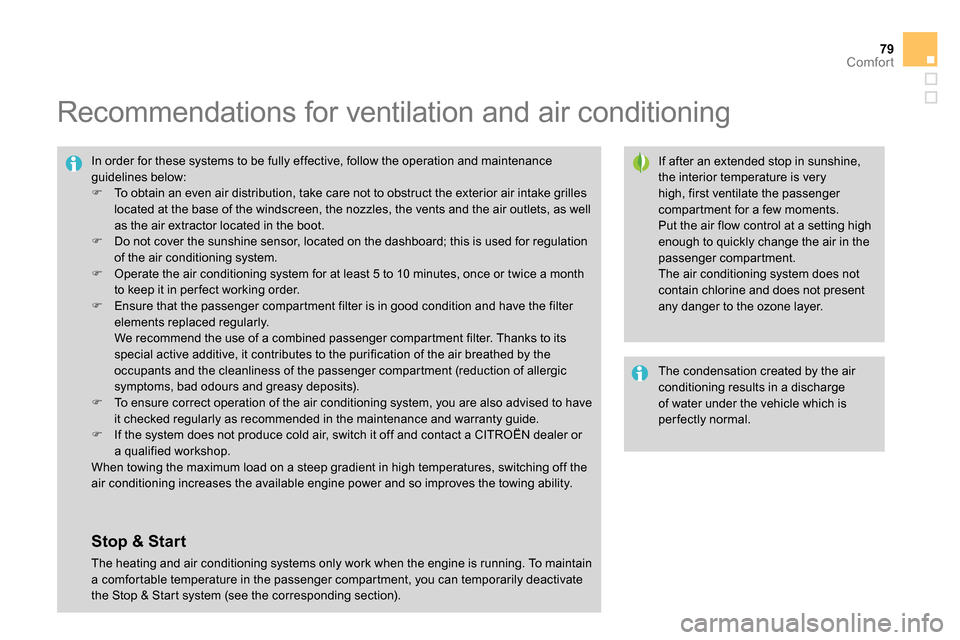
79Comfort
Recommendations for ventilation and air conditioning
If after an extended stop in sunshine,
the interior temperature is very
high, first ventilate the passenger
compartment for a few moments.
Put the air flow control at a setting high
enough to quickly change the air in the
passenger compartment.
The air conditioning system does not
contain chlorine and does not present
any danger to the ozone layer. In order for these systems to be fully effective, follow the operation and maintenance
guidelines below:
To obtain an even air distribution, take care not to obstruct the exterior air intake grilles
located at the base of the windscreen, the nozzles, the vents and the air outlets, as well
as the air extractor located in the boot.
Do not cover the sunshine sensor, located on the dashboard; this is used for regulation
of the air conditioning system.
Operate the air conditioning system for at least 5 to 10 minutes, once or twice a month
to keep it in per fect working order.
Ensure that the passenger compartment filter is in good condition and have the filter
elements replaced regularly.
We recommend the use of a combined passenger compartment filter. Thanks to its
special active additive, it contributes to the purification of the air breathed by the
occupants and the cleanliness of the passenger compartment (reduction of allergic
symptoms, bad odours and greasy deposits).
To ensure correct operation of the air conditioning system, you are also advised to have
it checked regularly as recommended in the maintenance and warranty guide.
If the system does not produce cold air, switch it off and contact a CITROËN dealer or
a qualified workshop.
When towing the maximum load on a steep gradient in high temperatures, switching off the
air conditioning increases the available engine power and so improves the towing ability.
The condensation created by the air
conditioning results in a discharge
of water under the vehicle which is
per fectly normal.
Stop & Start
The heating and air conditioning systems only work when the engine is running. To maintain
a comfortable temperature in the passenger compartment, you can temporarily deactivate
the Stop & Start system (see the corresponding section).
Page 85 of 400
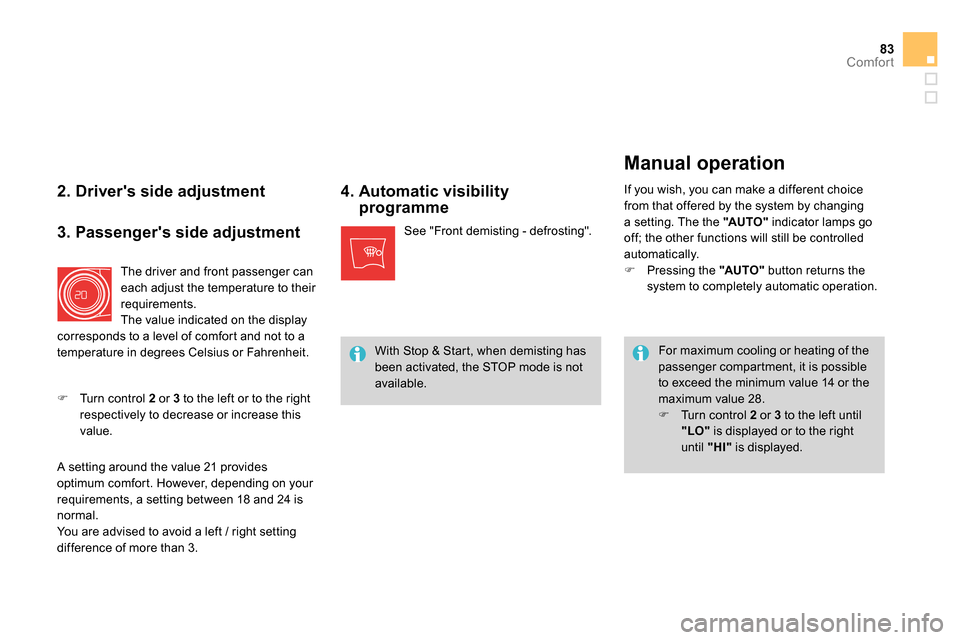
83Comfort
2. Driver's side adjustment
4. Automatic visibility
programme
For maximum cooling or heating of the
passenger compartment, it is possible
to exceed the minimum value 14 or the
maximum value 28.
Turn control 2
or 3
to the left until
"LO"
is displayed or to the right
until "HI"
is displayed. See "Front demisting - defrosting".
3. Passenger's side adjustment
The driver and front passenger can
each adjust the temperature to their
requirements.
The value indicated on the display
corresponds to a level of comfort and not to a
temperature in degrees Celsius or Fahrenheit.
Turn control 2
or 3
to the left or to the right
respectively to decrease or increase this
value.
A setting around the value 21 provides
optimum comfort. However, depending on your
requirements, a setting between 18 and 24 is
normal.
You are advised to avoid a left / right setting
difference of more than 3.
Manual operation
If you wish, you can make a different choice
from that offered by the system by changing
a setting. The the "AUTO "
indicator lamps go
off; the other functions will still be controlled
automatically.
Pressing the "AUTO "
button returns the
system to completely automatic operation.
With Stop & Start, when demisting has
been activated, the STOP mode is not
available.
Page 87 of 400
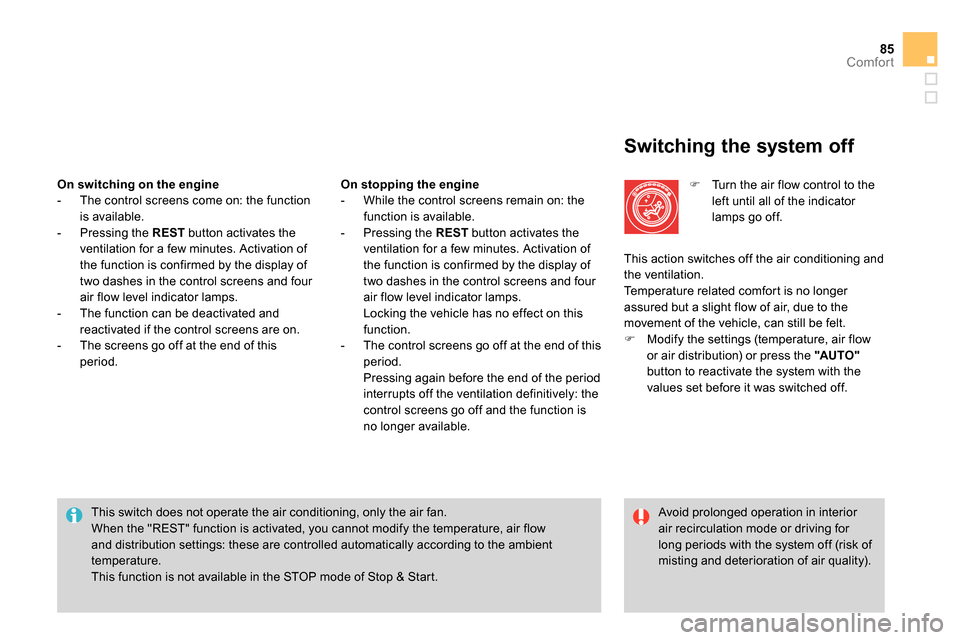
85Comfort
Switching the system off
Turn the air flow control to the
left until all of the indicator
lamps go off.
This switch does not operate the air conditioning, only the air fan.
When the "REST" function is activated, you cannot modify the temperature, air flow
and distribution settings: these are controlled automatically according to the ambient
temperature.
This function is not available in the STOP mode of Stop & Start.
Avoid prolonged operation in interior
air recirculation mode or driving for
long periods with the system off (risk of
misting and deterioration of air quality).
On switching on the engine
- The control screens come on: the function
is available.
- Pressing the REST
button activates the
ventilation for a few minutes. Activation of
the function is confirmed by the display of
two dashes in the control screens and four
air flow level indicator lamps.
- The function can be deactivated and
reactivated if the control screens are on.
- The screens go off at the end of this
period.
On stopping the engine
- While the control screens remain on: the
function is available.
- Pressing the REST
button activates the
ventilation for a few minutes. Activation of
the function is confirmed by the display of
two dashes in the control screens and four
air flow level indicator lamps.
Locking the vehicle has no effect on this
function.
- The control screens go off at the end of this
period.
Pressing again before the end of the period
interrupts off the ventilation definitively: the
control screens go off and the function is
no longer available. This action switches off the air conditioning and
the ventilation.
Temperature related comfort is no longer
assured but a slight flow of air, due to the
movement of the vehicle, can still be felt.
Modify the settings (temperature, air flow
or air distribution) or press the "AUTO "
button to reactivate the system with the
values set before it was switched off.
Page 88 of 400
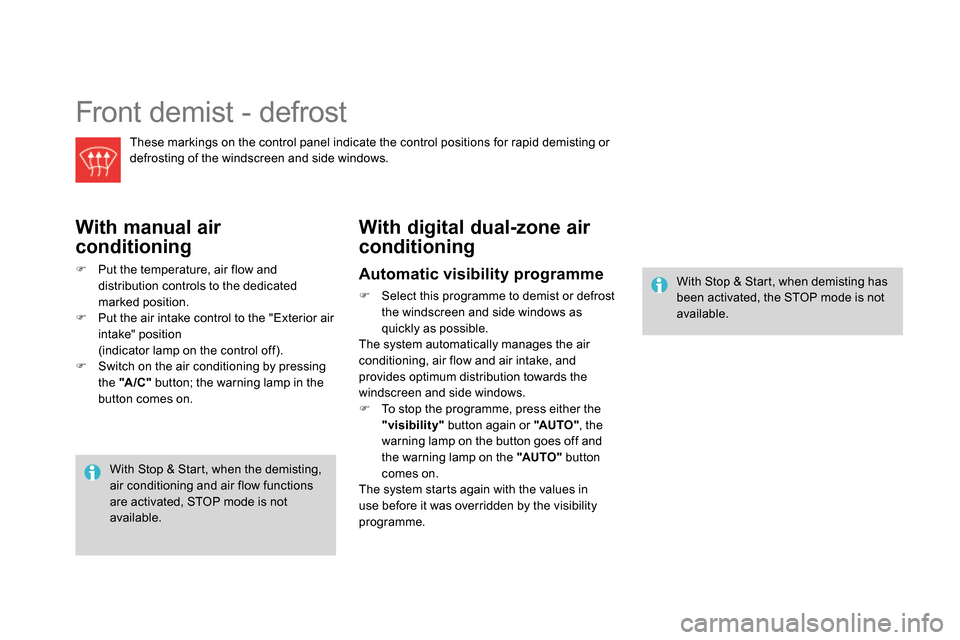
Front demist - defrost
These markings on the control panel indicate the control positions for rapid demisting or
defrosting of the windscreen and side windows.
With manual air
conditioning
Put the temperature, air flow and
distribution controls to the dedicated
marked position.
Put the air intake control to the "Exterior air
intake" position
(indicator lamp on the control off).
Switch on the air conditioning by pressing
the "A /C "
button; the warning lamp in the
button comes on.
With digital dual-zone air
conditioning
With Stop & Start, when the demisting,
air conditioning and air flow functions
are activated, STOP mode is not
available.
Automatic visibility programme
Select this programme to demist or defrost
the windscreen and side windows as
quickly as possible.
The system automatically manages the air
conditioning, air flow and air intake, and
provides optimum distribution towards the
windscreen and side windows.
To stop the programme, press either the
"visibility"
button again or "AUTO "
, the
warning lamp on the button goes off and
the warning lamp on the "AUTO "
button
comes on.
The system starts again with the values in
use before it was overridden by the visibility
programme.
With Stop & Start, when demisting has
been activated, the STOP mode is not
available.
Page 102 of 400
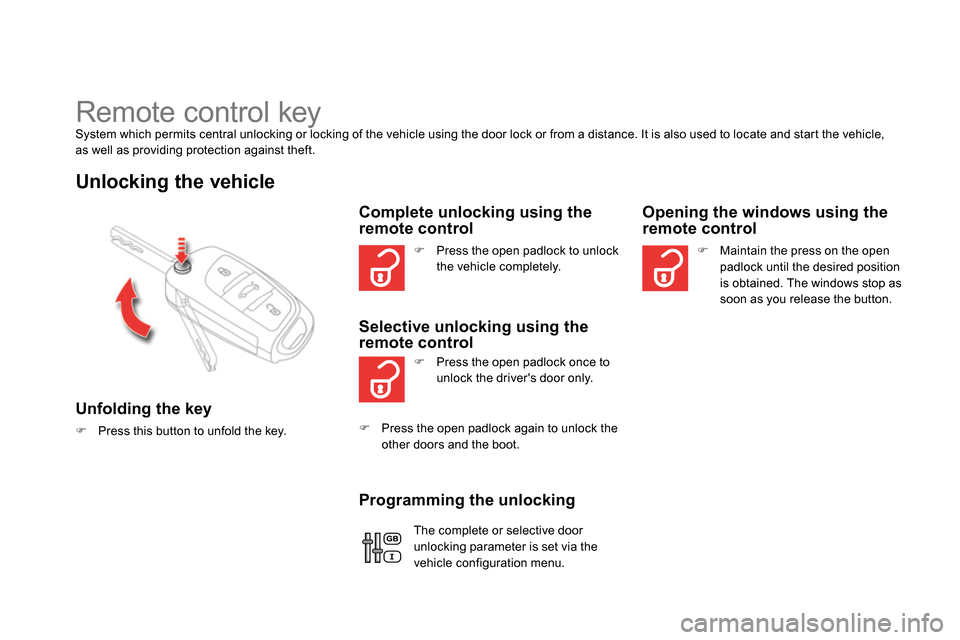
Remote control key
System which permits central unlocking or locking of the vehicle using the door lock or from a distance. It is also used to locate and start the vehicle,
as well as providing protection against theft.
Unlocking the vehicle
Unfolding the key
Press this button to unfold the key.
Complete unlocking using the
remote control
Selective unlocking using the
remote control
Press the open padlock to unlock
the vehicle completely.
Press the open padlock once to
unlock the driver's door only.
Press the open padlock again to unlock the
other doors and the boot.
Opening the windows using the
remote control
Maintain the press on the open
padlock until the desired position
is obtained. The windows stop as
soon as you release the button.
Programming the unlocking
The complete or selective door
unlocking parameter is set via the
vehicle configuration menu.
Page 107 of 400
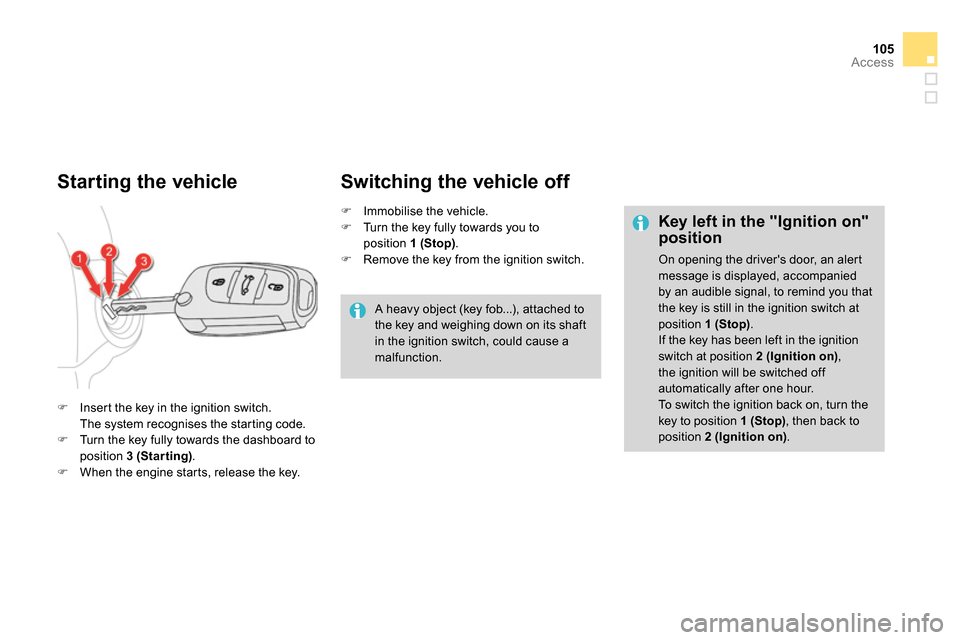
105Access
Starting the vehicle
Insert the key in the ignition switch.
The system recognises the starting code.
Turn the key fully towards the dashboard to
position 3 (Star ting)
.
When the engine starts, release the key.
Immobilise the vehicle.
Turn the key fully towards you to
position 1 (Stop)
.
Remove the key from the ignition switch.
Switching the vehicle off
A heavy object (key fob...), attached to
the key and weighing down on its shaft
in the ignition switch, could cause a
malfunction.
Key left in the "Ignition on"
position
On opening the driver's door, an alert
message is displayed, accompanied
by an audible signal, to remind you that
the key is still in the ignition switch at
position 1 (Stop)
.
If the key has been left in the ignition
switch at position 2 (Ignition on)
,
the ignition will be switched off
automatically after one hour.
To switch the ignition back on, turn the
key to position 1 (Stop)
, then back to
position 2 (Ignition on)
.
Page 109 of 400
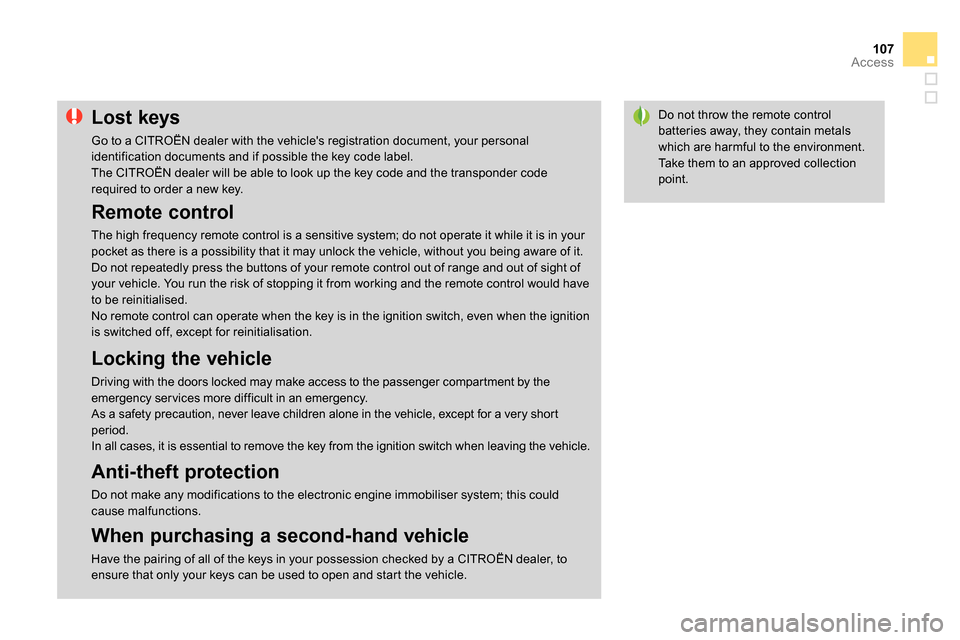
107Access
Do not throw the remote control
batteries away, they contain metals
which are harmful to the environment.
Take them to an approved collection
point.
Lost keys
Go to a CITROËN dealer with the vehicle's registration document, your personal
identification documents and if possible the key code label.
The CITROËN dealer will be able to look up the key code and the transponder code
required to order a new key.
Remote control
The high frequency remote control is a sensitive system; do not operate it while it is in your
pocket as there is a possibility that it may unlock the vehicle, without you being aware of it.
Do not repeatedly press the buttons of your remote control out of range and out of sight of
your vehicle. You run the risk of stopping it from working and the remote control would have
to be reinitialised.
No remote control can operate when the key is in the ignition switch, even when the ignition
is switched off, except for reinitialisation.
Locking the vehicle
Driving with the doors locked may make access to the passenger compartment by the
emergency ser vices more difficult in an emergency.
As a safety precaution, never leave children alone in the vehicle, except for a very short
period.
In all cases, it is essential to remove the key from the ignition switch when leaving the vehicle.
Anti-theft protection
Do not make any modifications to the electronic engine immobiliser system; this could
cause malfunctions.
When purchasing a second-hand vehicle
Have the pairing of all of the keys in your possession checked by a CITROËN dealer, to
ensure that only your keys can be used to open and start the vehicle.
Page 120 of 400
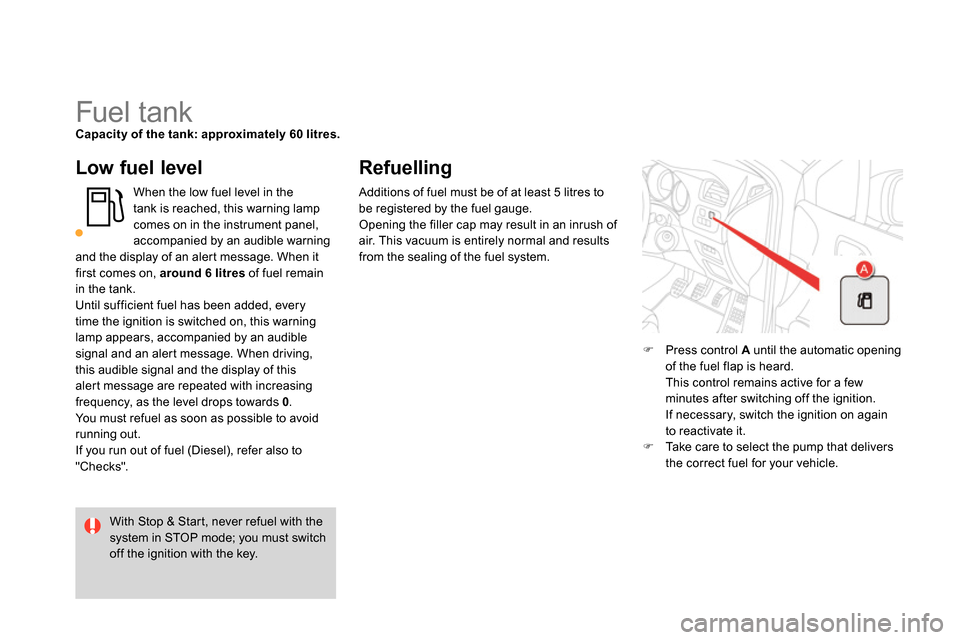
Fuel tank
Capacity of the tank: approximately 60 litres.
Low fuel level
When the low fuel level in the
tank is reached, this warning lamp
comes on in the instrument panel,
accompanied by an audible warning
and the display of an alert message. When it
first comes on, around 6 litres
of fuel remain
in the tank.
Until sufficient fuel has been added, every
time the ignition is switched on, this warning
lamp appears, accompanied by an audible
signal and an alert message. When driving,
this audible signal and the display of this
alert message are repeated with increasing
frequency, as the level drops towards 0
.
You must refuel as soon as possible to avoid
running out.
If you run out of fuel (Diesel), refer also to
"Checks".
Refuelling
Press control A
until the automatic opening
of the fuel flap is heard.
This control remains active for a few
minutes after switching off the ignition.
If necessary, switch the ignition on again
to reactivate it.
Take care to select the pump that delivers
the correct fuel for your vehicle.
With Stop & Start, never refuel with the
system in STOP mode; you must switch
off the ignition with the key. Additions of fuel must be of at least 5 litres to
be registered by the fuel gauge.
Opening the filler cap may result in an inrush of
air. This vacuum is entirely normal and results
from the sealing of the fuel system.
Page 181 of 400
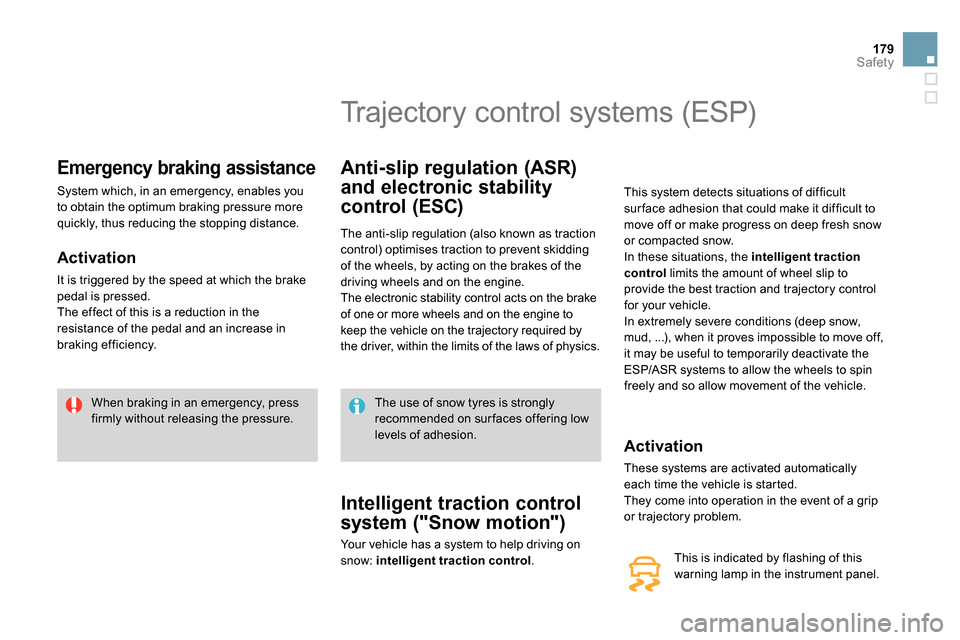
179Safety
Emergency braking assistance
System which, in an emergency, enables you
to obtain the optimum braking pressure more
quickly, thus reducing the stopping distance.
Activation
It is triggered by the speed at which the brake
pedal is pressed.
The effect of this is a reduction in the
resistance of the pedal and an increase in
braking efficiency.
When braking in an emergency, press
firmly without releasing the pressure.
Trajectory control systems (ESP)
Anti-slip regulation (ASR)
and electronic stability
control (ESC)
The anti-slip regulation (also known as traction
control) optimises traction to prevent skidding
of the wheels, by acting on the brakes of the
driving wheels and on the engine.
The electronic stability control acts on the brake
of one or more wheels and on the engine to
keep the vehicle on the trajectory required by
the driver, within the limits of the laws of physics.
Activation
These systems are activated automatically
each time the vehicle is started.
They come into operation in the event of a grip
or trajectory problem.
This is indicated by flashing of this
warning lamp in the instrument panel.
Intelligent traction control
system ("Snow motion")
Your vehicle has a system to help driving on
snow: intelligent traction control.
The use of snow tyres is strongly
recommended on sur faces offering low
levels of adhesion.
This system detects situations of difficult
sur face adhesion that could make it difficult to
move off or make progress on deep fresh snow
or compacted snow.
In these situations, the intelligent traction
control
limits the amount of wheel slip to
provide the best traction and trajectory control
for your vehicle.
In extremely severe conditions (deep snow,
mud, ...), when it proves impossible to move off,
it may be useful to temporarily deactivate the
ESP/ASR systems to allow the wheels to spin
freely and so allow movement of the vehicle.
Page 199 of 400
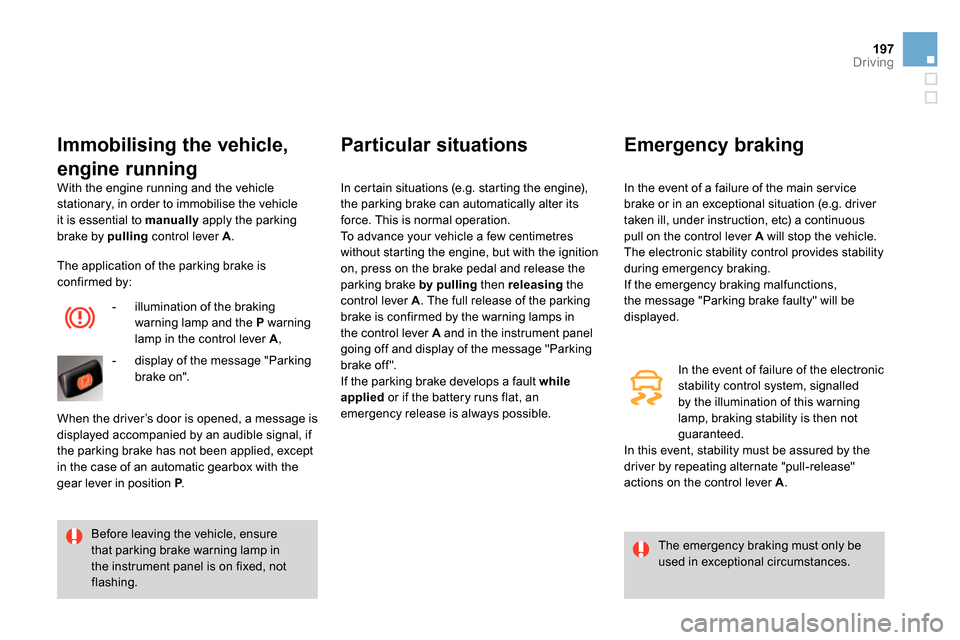
197Driving
With the engine running and the vehicle
stationary, in order to immobilise the vehicle
it is essential to manually
apply the parking
brake by pulling
control lever A
.
Immobilising the vehicle,
engine running
The emergency braking must only be
used in exceptional circumstances.
Before leaving the vehicle, ensure
that parking brake warning lamp in
the instrument panel is on fixed, not
flashing.
The application of the parking brake is
confirmed by:
- illumination of the braking
warning lamp and the P
warning
lamp in the control lever A
,
- display of the message "Parking
brake on".
When the driver’s door is opened, a message is
displayed accompanied by an audible signal, if
the parking brake has not been applied, except
in the case of an automatic gearbox with the
gear lever in position P
.
Particular situations
In certain situations (e.g. starting the engine),
the parking brake can automatically alter its
force. This is normal operation.
To advance your vehicle a few centimetres
without starting the engine, but with the ignition
on, press on the brake pedal and release the
parking brake by pulling
then releasing
the
control lever A
. The full release of the parking
brake is confirmed by the warning lamps in
the control lever A
and in the instrument panel
going off and display of the message "Parking
brake off ".
If the parking brake develops a fault while
applied
or if the battery runs flat, an
emergency release is always possible.
Emergency braking
In the event of failure of the electronic
stability control system, signalled
by the illumination of this warning
lamp, braking stability is then not
guaranteed.
In this event, stability must be assured by the
driver by repeating alternate "pull-release"
actions on the control lever A
. In the event of a failure of the main ser vice
brake or in an exceptional situation (e.g. driver
taken ill, under instruction, etc) a continuous
pull on the control lever A
will stop the vehicle.
The electronic stability control provides stability
during emergency braking.
If the emergency braking malfunctions,
the message "Parking brake faulty" will be
displayed.